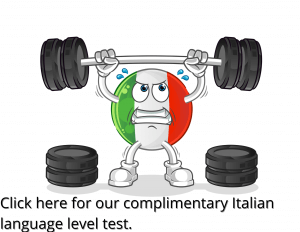Italian is arguably the most beautiful language in the world. Its speakers are lovely people who put a premium on enjoying life, eating well and looking stylish.
It is also considered to be a “category one language” by the Foreign Language Service of the US Department of State. What does it mean to be a “category one language” excatly? According to research carried out over the years on foreign service employees, the FSI calculates that an average language learner can achieve functional fluency in the language in about 6 months of full-time study, i.e., by studying the language from 25 to 31.25 hours per week for six months. Ultimately, to be a fluent in Italian, you will therefore need to spend about six hundred hours studying, speaking, listening, and reading it.
If your intention is to become fluent, in Italian, though, it is better to be realistic and focus on a series of small, achievable intermediary steps. In this article, in fact, I am going to lay out a road map to success in becoming fluent in Italian by breaking down what you will need to master at the various levels and what you need to focus on as you go along on your path to achieving mastery in Italian.
The levels of Italian proficiency follow the Common Framework of Reference for Languages, a handy system that breaks down the levels into a series of “Can-Do” statements that can be applied to any language, not just Italian.
So, here are the levels in a nutshell:
A1 – Principiante A (Beginner A)
After about one year of study, you are able to do the following:
Here is a list of the grammar items that you will have mastered: Coniugazioni del verbo “essere” (conjugation of the verb “to be”), coniugazione del verbo “avere” (to have), coniugazione dei verbi “-are”, “-ere”, “-ire” (conjugations of regular verbs with the ending “-are”, “-ere”, “-ire”), coniugazioini dei verbi irregolari (conjugations of common irregular verbs such as “andare”, “bere”, “vedere”), il presente indicativo (present simple tense), avverbi di frequenza (frequency adverbs such as “solitamente”, “sempre”, “mai”), aggettivi possessivi (possessive adjectives such as “mio”, “mia”, “miei”, “mie”, etc.), nomi delle professioni (name of the professions), dire l’orario (say the time), linguaggio per ordinare in un ristorante (expressions for ordering in a restaurant), descrivere luoghi geografici (describe geographical locations).
Do you think you might be at this level? Why not try out our level test? It consists of thirty questions and you can opt out at any time. Italian Assessment Test Link.
A2 – Principiante B (Beginner B)
During the A2 level, you begin to learn how to discuss and understand about events not just in the present, but also in the past and future. Your communicative ability at this level is still a bit formulaic as you are still very much concentrated on using the correct form and trying to remember the correct form of the verb.

However, by the end of this level, you will have learned il passato composto (“composite past” formed with the verb “avere” and the “past participle” of the main verb), il futuro semplice (the “simple future” formed by changing the ending of the verbs. Brace yourself for lots of drills on regular and irregular verbs!), linguaggio per parlare della salute (language for discussing physical health), l’imperativo (imperative form), preposizioni articolate (combined preposition and articles – again brace yourself for the tornado of vowels), il presente progressivo (the present continuous, e.g., “He is swimming” as opposed to “He swims”), il condizionale (the conditional form used for discussing hypothetical situations).
Do you think you might be at this level? Why not try out our level test? It consists of thirty questions and you can opt out at any time. Italian Assessment Test Link.
B1 – Pre-Intermedio (Pre-Intermediate)
The B1 level is special because it is when you start putting everything together and having interactions that resemble actual conversations in Italian. It is considered the “livello del perché” – “the level of why” – because it is the level at which you begin to be able to explain or justify the things you say. Instead of saying, “Sono andato al mare ieri mattina” (I went to the beach yesterday), you might say “Sono andato al mare anziché in montagna perché c’era un cielo limpido e non c’era vento.” (I went to beach instead of to the mountains because there wasn’t a cloud in the sky and there was no wind.).
Here is a list of the grammatical notions that you will pick up during this level: imperfetto (the past continuous), la causativa (the causative), la differenza tra il registro formal e informale (difference between formal and informal register), secondo caso ipotetico (second conditional for discussing hypothetical situations), il passato remoto (“remote past” tense used to denote actions far in the past or for literary effect), frasi relative (relative pronouns).
Do you think you might be at this level? Why not try out our level test? It consists of thirty questions and you can opt out at any time. Italian Assessment Test Link.
B2 – Intermedio (Intermediate)
Whereas B1 is the level of “Why?”, B2 is the level of “That depends” because it is at this level that you become proficient at discussing various points of view or advantages and disadvantages of something. Obviously, you have an opinion about something, but your Italian is good enough at this point to be able to perhaps concede a point or agree with someone in part. You also become proficient at discussing hypothetical situations by saying what would do in such-and-such situation or even what you should have done differently.
Here is a list of grammatical and semantical notions that you will become familiar with during this level: il congiuntivo al presente e al passato (the “subjunctive mood,” which is a verb declension used to indicate a mood or feeling about an event. We usually think of verbs as used for tenses, but they are used to express the feeling or sentiment associated with an action or thought), il passivo (passive voice), secondo e terzo caso ipotetico (second and third conditional statements), condizionale al passato con verbi modali (condiational past with modal verrbs), registro formale e informale nei documenti scritti (formal and informal register in written documents), approfondimento vocabolario – attualità, politica, intrattenimento, cucina, salute (vocabulary extension in the following topics – current events, politics, entertainment, cuisine and health).
Do you think you might be at this level? Why not try out our level test? It consists of thirty questions and you can opt out at any time. Italian Assessment Test Link.
C1 – Avanzato (Advanced)
At this point, you have already attained a high level of Italian proficiency: you know all of the grammar there is to know and you are able to understand, write and speak the language fluently at a normal conversational speed. What’s left? This is where you start to dig in to the nuances of the language and look at implicit meanings of words and start to hear the tone of what is being said in a conversation.
Here is a list of notions that you will study during your journey to the C1 level: locuzioni avverbiali (adverbial phrases), frasi relative complesse (complex subordinate clauses), discorso indiretto e diretto (direct and indirect speech), approfondimenti gerundi e participi passati (in depth look at gerunds and past participles), pronomi indefiniti (indefinite pronouns), vocabolario sofisticato e semplice (differences between sophisticated and simple vocabulary), proverbi italiani (proverbi italiani), espressioni tipiche e idiomatiche (stock phrases, idiomatic expressions), approfondimenti sulla letturatura italiana, storia italiana, cinema italiano (lessons about Italian literature, history and cinema).
Do you think you might be at this level? Why not try out our level test? It consists of thirty questions and you can opt out at any time. Italian Assessment Test Link.
C2 – Avanzato (Mastery)
Getting to this level of knowledge in Italian requires pazienza e lavoro sodo (patience and hard work) – congratulazioni! (Congratulations!)
In order to make that further leap from C1 to C2, continued and persistent study is required in order to gain a deeper and more automatic understanding of Italian culture, the subtext and cultural allusions that Italian writings and conversation are full of!
Here are some things that you might study in a C2 course: concordanza dei tempi (agreement among tenses), proverbi e espressioni idiomatiche (proverbs, stock phrases and idiomatic expressions), congiuntivo (subjunctive), approfondimento del vocabolario su ampia gamma di argomenti (vocabulary about a wide range of subjects), differenza tra parola scritta e parlata (difference between printed and spoken word).
Do you think you might be at this level? Why not try out our level test? It consists of thirty questions and you can opt out at any time. Italian Assessment Test Link.
This concludes our article about the stages in becoming fluent in Italian. It requires a bit of pazienza, but if you hang in there and set yourself small achievable goals, you will definitely get there.
There are a lot of wonderful activities out there that you can do. In previous articles we have discussed the relevance of language learning applications and about the importance of developing good language learning habits, but along your journey to learning Italian, you might want to consider the importance of learning with a teacher – especially with a Ciao Languages teacher who is a trained and experienced native speaking teacher skilled in the use of virtual technology. Contact us if you think you would like to learn more about our online language lessons!
Ciao Languages is based in Orange County, California and puts you in touch with languages from all over the world, from the convenience of your home! We are an online school, but we firmly believe in the motto “Making the Virtual Human.”



